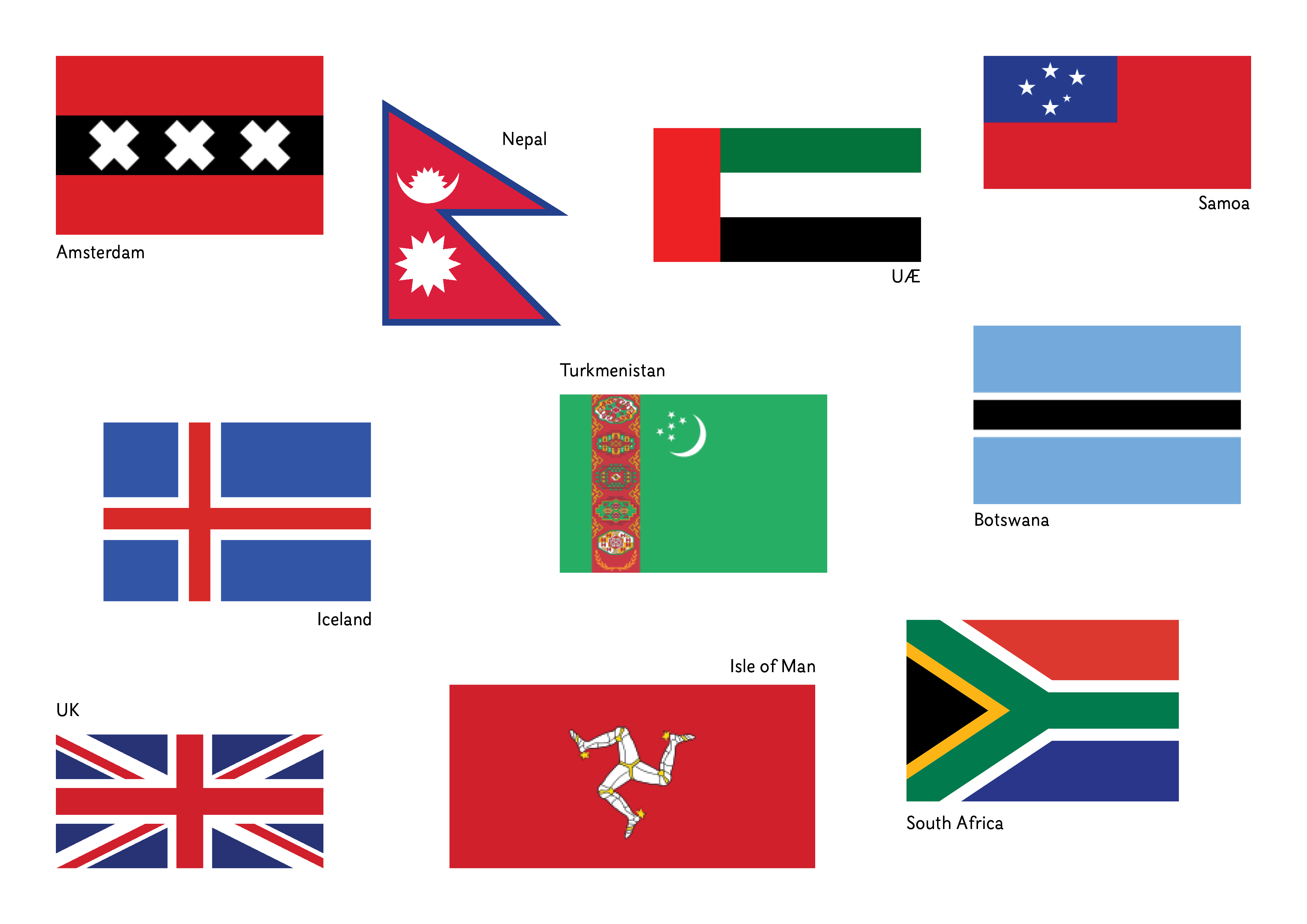Flags and their stories
People love flags. Just watch the news or look down the street. We burn them when we’re angry, wear them if we’re proud, or plant them in bits of land (or even the moon!) to claim it as our own. The comedian Eddie Izzard hilariously explains this in a sketch: the British “stole whole countries with the cunning use of flags.”

Flag origins
Let’s start at the beginning: where do flags come from? All roads lead to Rome, including the history of flags. They used the word ‘vexillum’ to refer to a stand with fabric hung from a horizontal crossbar, an object they held in battle. Flags were often used as a method of identification during battle – much like the Scots wore different tartans to differentiate what side they were on. It’s important to make sure you don’t kill your own guys. The flags also proved good for morale – they rally people around one unified symbol. We, the people who identify with that design of cloth, are one group.
The first national flags started out on big ships and at ports, again to identify who’s who (and who belongs to whom). The oldest flags still in use today are the Danish, Dutch and British ones, but most were adopted in the mid to late 20th century when post-colonialism and the collapse of the Iron curtain shaped many newly independent countries.
Now we have national flags, regional flags, city flags, religious flags, event flags (like the Olympics), cultural-group flags (the Kurds, for example), flags that signify sexual identity (the rainbow flag) or you could get your own company design made. Varied as they might be, there are a couple of ground rules which are good to keep in mind when you design one, to make sure both symbolism and aesthetics stay up to par.
Design your own
For starters, don’t use words. Historically they wouldn’t use words because many people were illiterate, but writing isn’t legible from far away anyway. Also, keep it simple. If your kid can’t draw it that probably means it’s getting too complicated. It also helps if the flag is applicable to a range of mediums. The Amsterdam city flag, the design of which journalist Roman Mars called ‘the most bad-ass flag in the world’, uses bold colours and three crosses. When you start looking for that flag you’ll find it everywhere, from sneakers to barbershop logos.
Colours, layouts & symbols
In case you didn’t pay attention in geography class, let me just give you a basic intro here. Flags from the same continent often share similar colours, layouts, and symbols. For example, of the 55 African states, 25 of them incorporate a star. In Europe, 17 flags have a three-bar horizontal layout, and 12 are red, white, and blue. Scandinavian countries all use the aptly named Scandinavian cross; the Pan-Slavic flags pretty much all use red, white and blue; and many Middle-Eastern countries use the Pan-Arab green, red, white and black. Though most flags are rectangular or square in shape, the Nepali flag refreshingly is the only national flag that literally does not fit in the box, with an unusual double triangle shape. Next time you need to guess a flag during a pub quiz, keep those snippets in mind.
Colours in flags are often symbolic. Depending on where you’re from, red can symbolise blood (UAE), bravery (Samoa), a volcano (Iceland) or the carpet industry (Turkmenistan). In Botswana’s flag, the colours symbolise the rainy season and zebras. Other symbols come in shapes, like stars, shields, crosses, suns or moons. Alternatively, the whole design of a flag can be symbolic. The Union Jack, the flag of the United Kingdom, is actually a combination of three different kingdom flags: Scotland, England and Northern Ireland (Wales didn’t get a great deal here).
The more intriguing flag designs includes the triskelion of three armoured legs on the Isle of Man flag. It is definitely an eye-catcher, yet no-one really knows how it ended up on there. In Namibia’s case, however, we know exactly what the plan was: their flag was created by an (American) graphic designer. Some flags are historic, some symbolic and others even designed. But there’s always a story.
Flag designer
Let’s get into that graphic designer I mentioned. It started with a late-night phone call. South Africa was just about to elect its first black president and the new country needed a new flag to go with it, ASAP. So far nothing good had come up, so Fredrick Brownell, the guy who had already designed the Namibian flag, got a call to get in the mix. He eventually came up with a sketch on the back of a booklet during an “interminable speech” at a flag conference in Zurich. With convergence and unification as the central concept, the design stood out when it came to decision time. A cabinet meeting was called and a fax was sent to Nelson Mandela (with someone having to run to the shop to get some pencils to colour in a grey print-out) and it was decided. New country – new flag.
Side fun fact: South Africa needed about 100.000 flags to cover the country by election day – but there was no way local manufacturers could manage that alone. So Dutch manufacturers exhausted Europe’s entire stock of flag material and ended up having to import from Japan to make sure enough were printed to have the brand new design fly across South Africa on election day.





